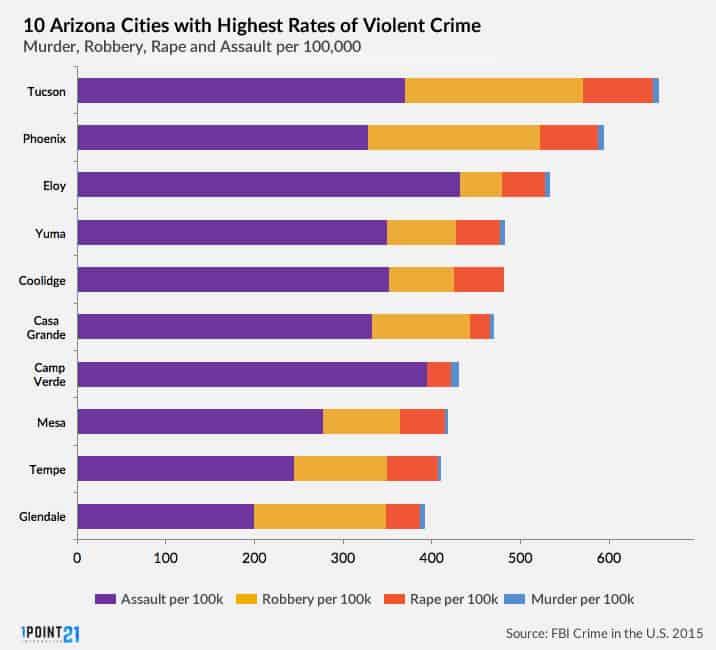Violent crime rates have surged across numerous cities in Arizona, raising concerns among residents and law enforcement officials alike. Recent data from The Arizona Republic reveal significant increases in incidents such as assault, robbery, and homicide in several urban areas, prompting calls for enhanced public safety measures. This uptick in violent offenses underscores the challenges faced by communities striving to curb crime and ensure the well-being of their citizens.
Rising Trends in Violent Crimes Across Arizona Urban Areas
Recent data reveals a noticeable surge in violent crime rates across several key urban hubs in Arizona. Cities including Phoenix, Tucson, and Mesa have reported increases in offenses such as aggravated assault, armed robbery, and homicides. Law enforcement officials express concern as these spikes challenge ongoing crime prevention efforts, stretching resources thin and raising public safety alarms. Contributing factors appear to span from economic pressures to social instability, highlighting a complex web of causes that local governments are striving to address.
Experts point to several specific trends driving the uptick in violence:
- Youth involvement: A rise in younger demographics entangled in violent activities has been noted.
- Gun-related incidents: A notable increase in firearms used during crimes.
- Gang activity: Intensified territorial disputes and recruitment efforts contribute to violent exchanges.
| City | 2023 Violent Crime Rate | % Increase Since 2022 |
|---|---|---|
| Phoenix | 854 per 100,000 | +12% |
| Tucson | 769 per 100,000 | +9% |
| Mesa | 698 per 100,000 | +7% |
Impact on Community Safety and Local Economies
The escalation in violent crime rates has sent ripples through Arizona’s neighborhoods, directly affecting residents’ sense of security and well-being. Many community members report heightened anxiety and a reluctance to engage in public activities, a sentiment that undermines neighborhood cohesion and trust. Schools, parks, and local events are increasingly viewed with caution, and the community’s collective spirit is strained as families prioritize safety over social engagement.
Local economies are equally vulnerable, with businesses facing a decline in foot traffic and increased security expenses. Entrepreneurs and small business owners express growing concerns about property damage, theft, and the rising costs of insurance premiums. The ripple effect is evident in:
- Reduced consumer spending due to fear of crime in commercial districts
- Lower property values as prospective residents reconsider moving to affected areas
- Challenges in attracting new investments and workforce, crucial for economic growth
| Impact Area | Effect |
|---|---|
| Retail Sales | Down 15% |
| Business Closures | Up 10% |
| Property Values | Declined 8% |
| New Investments | Delayed or Canceled |
Law Enforcement Strategies and Resource Allocation Challenges
Police departments across Arizona are grappling with the dual challenge of implementing effective crime deterrence measures while facing significant resource constraints. Agencies are increasingly employing data-driven approaches such as predictive policing and strategic patrol deployments to combat the surge in violent offenses. However, budget limitations and staff shortages hinder the ability to maintain a strong law enforcement presence consistently. Officers are often stretched thin, forced to prioritize calls based on severity rather than proactive community engagement or thorough investigations.
Key factors complicating law enforcement efforts include:
- Rising demand for criminal investigations with limited personnel
- Reduced funding for technology upgrades and training programs
- Challenges in coordinating multi-agency responses
- Balancing crime fighting with community relations initiatives
| Strategy | Effectiveness | Resource Impact |
|---|---|---|
| Predictive Policing | Moderate | High technological investment |
| Increased Foot Patrols | High | High personnel requirement |
| Community Partnerships | Variable | Low to Moderate |
| Inter-agency Task Forces | High | Moderate coordination effort |
Community-Based Initiatives and Policy Recommendations to Curb Violence
Local leaders and organizations across Arizona are joining forces to implement grassroots programs aimed at reducing violent crime. These initiatives focus on enhancing community engagement through mentorship projects, youth development activities, and neighborhood watch groups. By fostering strong social bonds and offering positive alternatives for at-risk populations, these efforts seek to address the root causes of violence rather than just its symptoms.
Policy experts urge lawmakers to adopt comprehensive strategies that include:
- Increased funding for mental health and substance abuse services
- Expansion of community policing models that promote trust and transparency
- Investment in affordable housing and employment programs to mitigate economic disparities
- Implementation of evidence-based violence interruption programs
| Initiative | Key Objective | Expected Impact |
|---|---|---|
| Youth Mentorship Programs | Guide teens towards positive life choices | Reduce juvenile delinquency rates |
| Community Policing | Build trust between law enforcement and residents | Increase crime reporting and cooperation |
| Violence Interruption | Mediate conflicts before escalation | Lower instances of retaliation shootings |
Wrapping Up
As violent crime rates continue to rise across numerous Arizona cities, local authorities and community leaders are facing mounting pressure to implement effective strategies to curb the trend. With public safety at the forefront of residents’ concerns, ongoing monitoring and coordinated efforts will be essential to address the underlying causes and restore a sense of security. The Arizona Republic will continue to provide updates and in-depth coverage as this critical issue develops.







